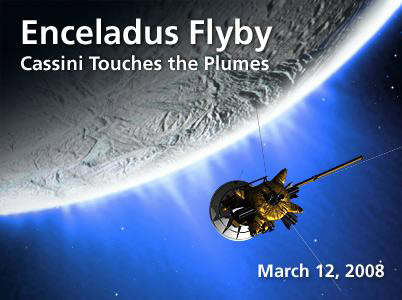Cassini Team Pushes for 7-Year Extended Mission at Saturn

SAN FRANCISCO - As NASA scientists continue toreport startling discoveries made during the Cassinispacecraft's initial tour of Saturn, a plan is being drafted that would extendthe mission through 2017.
Funding forthe Cassini program is scheduled to end Sept.30, 2010. However, the spacecraft remains in good shape and couldcontinue to return valuable data for years to come, scientists say, providedNASA approves the necessary funding to extendCassini's tour. Mission officials are preparing topresent their case for a seven-year extension to NASA headquarters next month.
"Thethings that is magic about seven more years is that Saturn will reach itsnorthern hemisphere's summer solstice," said Robert Mitchell, Cassini program manager at the Jet Propulsion Laboratory inPasadena, Calif."When we arrived in June 2004, it was a little ways past the southernhemisphere's summer solstice. If we could go seven more years, we would seenearly half of Saturn's orbit."
By monitoringSaturn during half of its 29-year trip around the sun, scientists hope to studythe effect of seasonalchanges on Saturn, its rings, and its moons Titan and Enceladus.Saturn's orbit is tilted 27 degrees relative to its equator. Just as it does onEarth, that tilt creates distinct seasons for different areas of the planet.
If the Cassini mission continues beyond 2010, scientists want toobserve seasonal changes around Titan'slakes of methane and Enceladus' south pole where vents spew ice crystals and water vapor,according to Carolyn Porco, Cassiniimaging team leader for the Space Science Institute in Boulder,Colo.
"Cassini has taken up residence in this magnificentplanetary system," Porco said. "We'vediscovered a tremendous amount. We want to stay and observe for as long aspossible."
The currentNASA budget includes approximately$80 million a year for Cassini's operations andscience. That money pays for an engineering team to operate the 12- instrumentspacecraft, a navigation team to keep it on course and 125 U.S.scientists associated with the program. In addition, 130 European scientistsparticipate in Cassini research.
Get the Space.com Newsletter
Breaking space news, the latest updates on rocket launches, skywatching events and more!
The Cassini-Huygens mission was developed cooperatively byNASA, the European Space Agency and the Italian Space Agency. NASA funding doesnot pay the salaries of the foreign scientists, but their work adds to theoverall cost of the mission because Cassini teamsdesign flights and instrument plans to cover their targets of investigation,Mitchell said.
Any Cassini mission that extends beyond 2010 would includefewer scientific investigations and operate at a much lower cost than thecurrent program. Initially, program officials hoped to plan an extended missionthat would cost $40 million per year, or half the current funding level."We concluded that wasn't quite enough to operate the spacecraft, keep iton track and conduct worthwhile science," Mitchell said.
As a result,proposals for the extended mission will include a range of funding levels withinformation on the scientific investigations that could be performed at eachlevel. "There is no single mission laid out," Mitchell said. "Weare looking at options."
Cassiniscientists are scheduled to gather in late January at the Jet PropulsionLaboratory to select the tour trajectories they would like the spacecraft tofollow if the mission is extended beyond 2010. Those plans will be presented toNASA headquarters for review in mid-February, Mitchell said.
In addition tociting the scientific goals that could be attained by extending Cassini's orbit of Saturn, the report to NASA headquarterswill provide a detailed description of the health of the spacecraft, which waslaunched in 1997. Overall, the spacecraft appears to be healthy. Someengineering subsystems show signs of wear and tear, but the spacecraftoperations team has developed a set of rules designed to treat those subsystemscarefully, Mitchell said.
Cassiniuses two types of fuel, hydrazine, which is used for small navigationmaneuvers, and a standard bipropellant for larger maneuvers. While there isample hydrazine to continue the mission through 2017, the Cassininavigation team has to be more conservative with its bipropellant. "Wewill design future tours knowing how much propellant is available for velocitychange," Mitchell said.
Recent toursthroughout the Saturn system have presented intriguing findings, such asevidence of what appear to be cryovolcanoes spewingextremely cold liquid into the atmosphere of Titan. Scientists also presentedhigh-resolution images at the American Geophysical Union meeting in SanFrancisco in December showing distinct changes over timein the appearance of the south pole of Enceladus.Those changes may indicate tectonicmovement on Enceladus similar to the tectonic activity found on Earth.
- Video - Cassini at Saturn: Four Years of Discovery
- Vote Now! Cassini's Greatest Hits: Images of Saturn
- Special Report: Cassini's Mission to Saturn
Join our Space Forums to keep talking space on the latest missions, night sky and more! And if you have a news tip, correction or comment, let us know at: community@space.com.
Debra Werner is a correspondent for SpaceNews based in San Francisco. She earned a bachelor’s degree in communications from the University of California, Berkeley, and a master’s degree in journalism from Northwestern University. Debra is a recipient of the 1989 Gerald Ford Prize for Distinguished Reporting on National Defense. Her SN Commercial Drive newsletter is sent out on Wednesdays.









